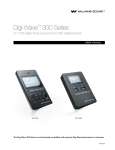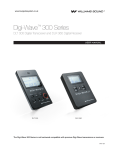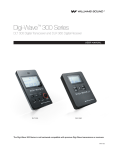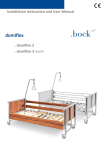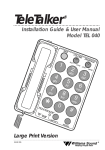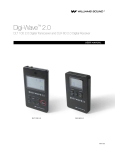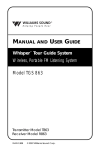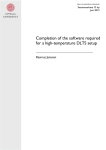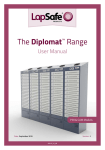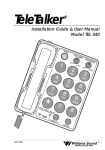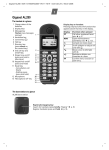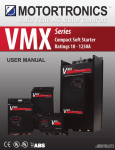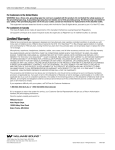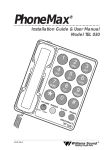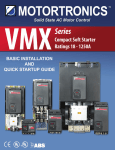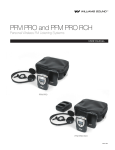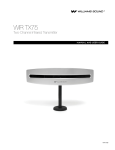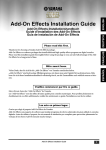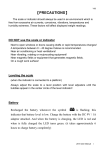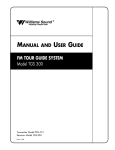Download Digi-Wave™ 300 Series
Transcript
Digi-Wave™ 300 Series DLT 300 Digital Transceiver and DLR 360 Digital Receiver USER MANUAL DLT 300 DLR 360 The Digi-Wave 300 Series is not backward compatible with previous Digi-Wave transceivers or receivers. MAN 195A DigiWave 300 Series Digital Transceiver and Receiver Digi-Wave™ 300 Series DLT 300 Digital Transceiver and DLR 360 Digital Receiver Contents Safety Warnings and Recycling Instructions.............................................................................................................................. 3 System Overview...................................................................................................................................................................... 4 DLT 300 Controls and Connectors........................................................................................................................................... 5 DLT 300 Operation................................................................................................................................................................... 5 Button Functions............................................................................................................................................................... 5 DLR 360 Controls and Connectors........................................................................................................................................... 7 DLR 360 Operation.................................................................................................................................................................. 7 Getting Started: Preprogrammed Systems............................................................................................................................... 8 Before Programming the Digi-Wave™ System.......................................................................................................................... 9 Programming the Digi-Wave™ System for 1-way Modes........................................................................................................ 11 Programming the Digi-Wave™ System for 2-way Modes........................................................................................................ 12 Programming the Digi-Wave™ System: DLT Optional Settings.............................................................................................. 13 Example 1: 2-way Mode, Tour Guide..................................................................................................................................... 15 How it works................................................................................................................................................................... 15 2-Way Setup for Tour Guide Operation............................................................................................................................ 16 Example 2: Simultaneous Interpretation (1-way)..................................................................................................................... 18 How it works................................................................................................................................................................... 18 1-way setup for simultaneous interpretation.................................................................................................................... 19 Example 3: Intercom (2, 3, 4, 5 or 6 simultaneous talkers) ................................................................................................... 20 How it works................................................................................................................................................................... 20 2-way setup for Intercom................................................................................................................................................ 21 Example 4: Repeater Mode.................................................................................................................................................... 22 REPEATER MODE setup................................................................................................................................................. 22 Differences between DLT 300, DLT 100 2.0 and DLT 100....................................................................................................... 24 Differences between DLR 360, DLR 60 2.0 and DLR 60......................................................................................................... 25 Differences between DLT 100, DLT 100 2.0, and DLT 300 firmware versions.......................................................................... 25 Specifications......................................................................................................................................................................... 26 DLT 300 Transceiver........................................................................................................................................................ 26 DLR 360 Receiver........................................................................................................................................................... 27 Troubleshooting...................................................................................................................................................................... 28 FAQs...................................................................................................................................................................................... 29 FCC statements..................................................................................................................................................................... 30 2-year Warranty...................................................................................................................................................................... 31 2 DigiWave 300 Series Digital Transceiver and Receiver Safety Warnings and Recycling Instructions HEARING SAFETY CAUTION! This product is designed to amplify sounds to a high volume level which could potentially cause hearing damage if used improperly. To protect your hearing and the hearing of others: (1) Turn the volume down before putting on the earphone or headphone, and then adjust the volume to a comfortable level, (2) Set the volume level at the minimum setting that you need to hear, (3) if you experience feedback (a squealing or howling sound), reduce the volume setting and move the microphone away from the earphone or headphone, and (4) Do not allow children or other unauthorized persons to have access to this product MEDICAL DEVICE SAFETY CAUTION! 1. Before using this product with an implantable or other medical device, consult your physician or the manufacturer of your implantable or other medical device. 2. If you have a pacemaker or other medical device, make sure that you are using this product in accordance with safety guidelines established by your physician or the implantable device manufacturer. RECYCLING INSTRUCTIONS Battery Safety and Disposal Help Williams Sound protect the environment! Please take time to dispose of your equipment properly. Please do NOT dispose of batteries in the household trash. Please take the batteries to a retail or community collection point for recycling. Product Recycling: Please do NOT dispose of your Williams Sound equipment in the household trash. Please take the equipment to an electronics recycling center or return the product to the factory for proper disposal. 3 DigiWave 300 Series Digital Transceiver and Receiver System Overview The Digi-wave™ system is a patented, digital spread-spectrum (DSS), simultaneous two-way wireless listening system operating in the 2.4 GHz band. Due to it’s frequency-hopping algorithm, it avoids interference and is a very secure method of communication. For a more detailed explanation of how Digi-wave technology works, please visit our website and download the “Digi-wave™ Technology White Paper” (under “Support – Downloads - Tech Bulletins”). A Digi-Wave communication system consists of at least one transceiver (DLT 300 ) and various combinations of transceivers and receivers (DLR 360 ) depending on the venue. The DLT 300 is a 2-way transceiver, meaning that it can transmit and receive audio simultaneously. It can operate in one of 3 different modes: 1.In Two-way Mode, a speaker (with a DLT 300) can hear another speaker’s voice (from a second DLT 300) and, at the same time, can also transmit their own voice. In this way, two-way communication is established (similar to a phone conversation). Two-way mode can only be established between DLT 300 units. In addition, DLR 360 receivers in the same group can also hear the broadcast. 2.In One-way Mode, one DLT 300 acts as a transmitter (speaker) and another DLT 300 acts as a receiver (listener). In addition, DLR 360 receivers in the same group can also hear the broadcast. There are 4 one-way modes. 3.In Repeater Mode, the DLT 300 receives audio from another DLT 300 and re-broadcasts the signal to increase the transmitted range of the person speaking. In this way, larger groups can be covered by using one or more DLT 300’s acting as repeaters. Listeners can have either DLT 300’s or DLR 360’s to listen to the broadcast. 4. In Intercom Mode, up to six people can talk simultaneously. All of the DLT 300’s are in 2-way mode in the same group. More DLT’s can be in the group, but only six can have live mics at the same time (the seventh DLT who wishes to speak pushes their TALK button and knocks the sixth talker off). DLR’s can listen-in on the conversation if desired. The Repeater function only operates in 1-way mode. It is not available in a 2-way scenario. The DLR 360 is a receiver only. Users of receivers can only hear what is being broadcast by DLT(s). Combinations of one or more DLT 300’s and DLR 360’s in One-way mode, Two-way mode, or Repeater mode can be used to facilitate different events, depending on what needs to be spoken and what needs to be heard. Examples of scenarios will be covered here. Typical Scenarios include: Guided Tours - with one or more tour guides (2-way), with audience participation (2-way), or without audience participation (1-way) Language Interpretation - one or more interpreted languages transmitted to audience (1-way) Intercom - with up to six people able to speak simultaneously (2-way) Note: there are many more scenarios than are covered in this manual, however these would be variations on the ones discussed here. Rules of Operation for 1-way or 2-way mode must be followed for successful operation. Note: for simplicity, throughout the rest of this manual, the DLT 300 may be referred to as a “DLT” and the DLR 360 may be referred to as a “DLR”. Similarly, Master 1, Master 2 and Guest may be referred to as “M1”, “M2”, and “GST”. The Digi-Wave 300 Series is not backward compatible with previous Digi-Wave transceivers or receivers. 4 DigiWave 300 Series Digital Transceiver and Receiver DLT 300 Controls and Connectors INTERNAL SPEAKER LCD DISPLAY LED INDICATORS TALK BUTTON WITH BRAILLE DOT VOLUME / SELECT UP VOLUME / SELECT DOWN POWER / MENU HEADPHONE JACK 3.5 MM MIC JACK 3.5 MM INTERNAL MICROPHONE 30-PIN DOCKING/ CHARGING CONNECTOR DLT 300 Operation A540 BUTTON FUNCTIONS POWER / MENU BUTTON ·· Press and hold for power On/Off ·· Press once to change section when in setup menu ·· Review setup (push repeatedly to advance to next setting) ·· Attendance checking can only be done with a Master unit. Must have address assigned between 1 — 99 to allow attendance checking function. To check attendance, push and release the button and the number of attendees will be displayed for 2 seconds. 5 DigiWave 300 Series Digital Transceiver and Receiver QUICK GROUP CHANGE / SETUP BUTTONS ·· Press and hold and together for 3 seconds to enter setup menu ·· Press and hold button for 3 seconds to enter quick group change mode. The GRP light will flash. Then use or to change groups. To exit, push again or just wait until the unit times out. ·· Use these buttons to select channels in simultaneous interpretation mode MICROPHONE LEVEL ADJUSTMENT ·· Hold the button for two seconds to enter mic level adjustment. For level adjustment use LINE LEVEL ADJUSTMENT ·· Hold the button for two seconds to enter mic level adjustment. For level adjustment use TONE ADJUSTMENT ·· Press and hold the – and + buttons ·· Using the -/+ buttons or simultaneously for 2 seconds. The LCD will display the last tone setting t: (1 - 9). , adjust the tone up or down:1 = Most bass ·· Press and hold the – and + buttons or 5 = Flat (Default) 9 = Most treble simultaneously for two seconds to save the tone setting. VOLUME CONTROL / SELECT BUTTON ·· Control / Volume ·· Use to navigate selections in setup menu. ·· Access and adjust tone control (0-53) TALK BUTTON ·· Press button momentarily once to activate the microphone. Press button once more to turn off the microphone ·· P ress and hold the button for approximately 2 seconds to mute other DLT 300 Guest units. Only the M1 and M2 have this function. ([TALK] LED will blink on all units when in mute mode). Battery Charging – DLT 300 1. This Product uses an internal rechargeable Lithium Polymer battery. 2. U se the 30 Pin connector, located on the bottom of DLT 300 to charge the battery. Full charging time is approximately 12 hours. The Red LED flashes while charging. The Green LED will be on steady when the battery is charged. 3. Battery Maintenance - Charge the battery at room temperature. 6 DigiWave 300 Series Digital Transceiver and Receiver 30-PIN DOCKING/ CHARGING CONNECTOR DLR 360 Controls and Connectors HEADPHONE JACK 3.5 MM LANYARD SLOT SPEAKER STRENGTH DLT#1 STRENGTH DLT#2 ANTENNA SYMBOL NUMERIC TYPE BATTERY STRENGTH NUMERIC DISPLAY RED LED GREEN LED VOLUME ADJUST CH/GROUP CHANGE POWER BATTERY TYPE BATTERY SWITCH COMPARTMENT 30-PIN DOCKING/ CHARGING CONNECTOR SPEAKER DLR 360 Operation 1. Insert 2 AAA batteries into the DLR. Observe correct polarity. You can use either Alkaline or NiMH, but make sure the battery switch is in the NiMH position to charge NiMH batteries. If Alkaline batteries are used, put the battery switch in the ALK position. 2. Power on/off by holding the power button for 3 seconds. 3. In 1-way mode, the DLR will seek active DLTs; press channel button up or down to seek next active DLT. In 2-way mode, group must be selected. 4. The Antenna Symbol will flash, and there will be no Signal Strength Bars, if not synchronized with a DLT. 5. If the units are synchronized, briefly push the power button 6. To change group, hold the 7. Use or 8. Hold and and to show group assigned (0 to 99). buttons for 3 seconds until “GROUP” is flashing. buttons to select group number. buttons for 3 seconds again to save the group number. 9. To change volume level press or buttons, display will show 00 through 30. 10. User can listen using the speaker on the back of the DLR or by plugging in stereo or mono earphones into the jack (which defeats the speakerBATTERY operation). TYPE BATTERY A539 SWITCH 11. Low battery indicator will show COMPARTMENT as a blinking battery symbol with no bars inside it. 12. The DLR will automatically power down after 5 minutes if not synchronized with a DLT. Battery Charging – DLR 360 1. This Product can charge AAA NiMH batteries in the battery compartment when the battery switch is in the NiMH position. 2. U se the 30 Pin connector, located on the bottom of DLT 300 to charge the battery. Full charging time is approximately 5 hours. The Red LED flashes while charging. The Green LED will be on steady when the battery is charged. 3. Battery Maintenance - Charge the battery at room temperature. 7 DigiWave 300 Series Digital Transceiver and Receiver Getting Started: Preprogrammed Systems If a system has been purchased, you should not need to perform any programming. The system will have been configured to your order. Turn Master 1 on first so other units can pair. Guest units will turn off after 5 minutes if they cannot find a master. 1. Charge all DLTs. If using DLRs, either charge them with NiMH batteries or insert fresh Alkaline batteries. Make sure the battery switch is in the correct position for “Alkaline” or “NiMH”. Any DLRs that will be used should have fresh batteries. 2. Identify and turn on the Master 1 first, usually identified by a grey silicone cover. Turn on the DLT by holding the power button until the LCD screen comes on. If Master 2 or Guests are powered up first they will turn off after a few minutes if not paired with the M1. As Master 2 and Guests are paired with the M1 the M1 and M2 will show C-#. The # refers to how many DLTs are paired within the group, i.e. C-12 means that 12 DLTs are paired with the M1 or M2 within their group. This can be utilized as an attendance checker making sure everyone is connected with the group. 3. Once all the DLTs are on, you can check the set-up status of all units by pressing the power/menu button momentarily to scroll through the settings: Master 1 and Master 2 screens will display: C-6 (Chairman plus six = number of participants within the group). ADD Address number (0 – 1023). Each DLT must have its own individual address. Group number (0 – 1023) must be the same number for the group. CODE Only shows if a code has been entered (code number will NOT be displayed). “F-#” Denotes software version. Time Displays the time of day. All Guest units will display: Address Number Group Number Secure Key Code (if entered) Software Version Time of Day 4. If headsets are to be worn, plug them into the jacks on the top of the DLTs making sure that the Microphone and Earphone plugs are fully inserted into the correct jacks. 5. The Master 1 will usually be the first speaker and should press the talk button momentarily to activate the microphone. This will be confirmed by the red LED around the talk button illuminated. If the talk LED is flashing, the talk button was held too long and the talk mute has been activated in the system. Hold the talk button until the LED’s stop flashing to deactivate talk mute. 6. The Master 2 and all Guest units should now be hearing audio from the M1 unit. Listening volume levels can be adjusted by pressing the – or + button. One other DLT can activate the Talk button for team tour or teach applications. A maximum of two talkers can be activated at any one time. For a Guest unit to talk, either the M1 or M2 will have to turn their talk button off by quickly pressing their talk button. 8 DigiWave 300 Series Digital Transceiver and Receiver Before Programming the Digi-Wave™ System Depending upon the mode chosen, up to six people can talk in a group at any given time. The M1 will have first priority, M2 has second priority and Guest units have third priority. When two or more people are talking in a group, the participants can hear their voices with the DLTs or DLRs. The M1 and M2 have the ability to lock out other talkers by holding down the TALK button for three seconds. All system TALK LEDs will continuously flash while other participants are locked out of the TALK feature. There are 4 basic steps to programming a Digi-Wave system. 1. Decide which mode you need. A. 2-Way Modes In 2-way mode, DLTs can hear and talk to each other, just like having a phone conversation or a conference call. DLRs can listen to the conversation. Common applications include: Tours with multiple Tour Guides, Tours with audience participation (Q&A), Wireless Intercom, Portable Discussion and Personal Communication. There are two 2-way Modes represented by these symbols on the LCD Display: 2-way: (4 simultaneous talkers maximum) 2-way - Intercom: (6 simultaneous talkers maximum) Rules of Operation (2-way modes) The following rules must be followed. Failure to adhere to these rules will result in unpredictable, unsupported operation. • There must be one, and only one Master 1 (M1) per group. • If the M1 unit is off, the Master 2 and Guest units will turn off after a few minutes. • Master 2 is optional and there can only be one per group. • Each DLT must have its own address and the address cannot be duplicated within a group. • Maximum 4 talkers (in 2-way mode) or 6 talkers (in 2-way Intercom mode) can operate simultaneously within a group. • Maximum four Groups can operate simultaneously within the same area, but each group must be assigned its own group number. • When using four simultaneous groups, group numbers must be sequential. i.e. 11, 12, 13, 14. Any numbers 0-1023 can be used (or 0-99 if DLRs are used in the system). • Attendee count will only work with addresses 1-99 (Maximum 100 DLT’s with one Master 1 at address 0). • With Secure Key Code active, all DLTs within the group must have the same 4-digit code entered. (DLRs will not work with secured DLTs) B. 1-Way Modes In 1-way mode, communication flows in one direction. It flows from the main speaker’s DLT, to secondary DLTs or DLR’s. If repeater mode is used, the repeater DLTs listen to the primary DLTs and transmit to DLTs and DLRs assigned to the same Group/Channel. The most common applications are: Simultaneous Interpretation with one or more interpreters, or Tours without audience participation (no Q&A). There are (4) 1-way Modes represented by these symbols on the LCD Display: 1-way - Main Speaker: (talks on Channel 0) 1-way - Interpreter: (receives on Channel 0, speaks on Channel designated for their language) 1-way - Repeater Mode: 1-way - Listen Only: (Units out of range of the primary unit(s) receive their broadcast from these units) (receive the broadcast from either the primary units or the repeater units, depending on range) 9 DigiWave 300 Series Digital Transceiver and Receiver Rules of Operation (1-way modes) The following rules must be followed when setting up any Digi-Wave™ system. Failure to adhere to these rules will result in unpredictable, unsupported operation. • Up to 15 channels can be used simultaneously, i.e. one floor and 14 interpreters. • There must be one Master 1 (usually this is also the floor), and only one, per group. • Each Interpreter must be assigned their own channel number. • Repeater function can only be used in 1-Way mode. • When repeater function is used, all 15 channels can be utilized in one-way mode, i.e. one floor and 14 interpreters. • When repeaters are used, Floor (channel 0) must be assigned as the master unit for the group. All other DLTs have to be assigned as “GST”. 2. Decide Speaking Priority for each DLT. There are 3 levels of priority. The M1 has first priority, M2 has second priority and Guest units have third priority. The M1 or M2 will have to turn OFF their talk access to allow the Guest units to talk. When 2-6 people are talking in a group the participants can hear their voices in the DLTs or DLRs. The M1 and M2 have the ability to lock out other talkers by holding down the TALK button for three seconds. All system TALK LEDs will continuously flash while other participants are locked out of the TALK feature. The Master 1 can override anyone else talking within the group. Master 2 has talking priority over Guests. Speaker priority is assigned as follows: 1st priority — Master 1 ( M1 ): 2nd priority — Master 2 ( M2 ): 3rd priority — Guest ( GST ): 3. Decide what Address(es) you will need. Each DLT transceiver must have a unique address. Refer to the “Rules of Operation” (under Step 1) for the mode you are using, to determine how you will address the units. 4. Decide what Group(s) you need. Each set of people who want to talk and/or listen to each other must be in the same group. Up to 4 Groups can operate simultaneously within range of each other. 10 DigiWave 300 Series Digital Transceiver and Receiver Programming the Digi-Wave™ System for 1-way Modes There are 4 basic steps to programming a Digi-wave system: 1. Set Mode: 2-way or 1-way 2. Set Priority: Master 1, Master 2, and Guest 3. Set Channel 4. Set Group Number Most of the programming is done on the DLT(s); the receivers just need to be assigned the correct group number. The Master 1 should be programmed first - all other units synchronize with the Master 1. Step 1. Set Mode: 1-way a. With the DLT turned on, press and hold the b. Use either of the the and buttons until the icons on the display begin flashing. buttons to scroll through the different icon combinations (modes). c. When you reach the 1-way mode you are looking for (below), go to step 2. 1-way - Main Speaker: 1-way - Interpreter: 1-way - Repeater Mode: 1-way - Receive or Listen Only: Step 2. Set Priority: Master or Guest a. Push the button to advance to the priority setting. b. Use either of the the buttons to scroll through the different priorities. Speaker priority is assigned as follows: 1st priority — Master: 2nd priority — Guest: (Must have one master per group) (All other units in the group) c. When you reach the priority you want, go to the next step. Step 3. Set Channel a. Push the button to advance to the address setting. “CH” will flash and the current address will be displayed. b. Use either of the the buttons to change the address. Step 4. Set Group Number a. Push the button to advance to the group setting. “GROUP” will flash and the current group will be displayed. b. Use either of the the buttons to change the group. c. All units operating together should have the same group number. 11 DigiWave 300 Series Digital Transceiver and Receiver Programming the Digi-Wave™ System for 2-way Modes There are 4 basic steps to programming a Digi-wave system: 1. Set Mode: 2-way or 1-way 2. Set Priority: Master 1, Master 2, and Guest 3. Set Address 4. Set Group Number Most of the programming is done on the DLT(s); the receivers just need to be assigned the correct group number. The Master 1 should be programmed first - all other units sychronize with the Master 1. Step 1. Set Mode: 2-way There are (3) 2-way Modes represented by these symbols on the LCD Display: 2-way: 2-way - Listen only: 2-way - Intercom: a. With the DLT turned on, press and hold the b. Use either of the the and buttons until the icons on the display begin flashing. buttons to scroll through the different icon combinations (modes). c. When you reach 2-way mode, the icon(s) will be flashing (alternately). Go to step 2. Step 2. Set Priority: Master 1, Master 2, and Guest a. Push the button to advance to the priority setting. b. Use either of the the buttons to scroll through the different priorities. Speaker priority is assigned as follows: 1st priority — Master 1 ( M1 ) : (Must have one per group) 2nd priority — Master 2 ( M2 ) : (Optional) 3rd priority — Guest ( GST ) : (All other units in the same group) c. When you reach the priority you want, go to the next step. Step 3. Set Address a. Push the button to advance to the address setting. “ADD” will flash and the current address will be displayed. b. Use either of the the buttons to change the address. c. Each unit must have a different (unique) address assigned. Step 4. Set Group Number a. Push the button to advance to the group setting. “GROUP” will flash and the current group will be displayed. b. Use either of the the buttons to change the group. c. All units operating together should have the same group number.. 12 DigiWave 300 Series Digital Transceiver and Receiver Programming the Digi-Wave™ System: DLT Optional Settings Secure Key Code: When a group has been set up and the same Secure Code has been entered into all the DLTs, the DLTs without this Secure Original (save) Code entered cannot listen in on the group. This may be desirable in private or high security-level functions. The same four digit code must be programmed into all of the DLTs, Master 1, Master 2 and Guests. If a different secure code has been entered, participants cannot re-enter the group without re-entering the correct secure code. The only time the Secure Code is displayed is when it is being entered. To block users from entering the set-up mode, refer to the SET-UP LOCK (SLOC) feature (below). 1. Choose a 4 digit numerical code; i.e. 1357. You must use the same code on each DLT in the group. Original (save) 2. Start with the Master 1 when programming. 3. With the DLT turned on, hold the enter the set-up menu. 4. Use the menu button in figure 1. and Secure Key Code fig. 1 Secure Ke Secure Key Code fig. 2 FIGURE 2 Ptt & PnL fig. 6 SLOC fig Ptt & Pn buttons simultaneously for two seconds to to scroll through the menu pages until you get to the screen displayed Secure Key Code fig. 1 5. The first dash will be blinking (figure 1); using the (0 – 9). 6. Press the menu button FIGURE 1 button, enter first digit of the code again to move to the second dash which will now be blinking. 7. Enter the next digit and continue until all four digits have been entered. 8. One more press of the menu button and you will see the word CodE displayed (figure 2). 9. With the Secure Key Code entered, exit the set-up menu by holding the seconds. and Ptt & PnL fig. 6 buttons simultaneously for two Ptt & PnL fig. 6 Side Ton 10. Follow the same process with the Master 2 and Guest units. Original (save) NOTE: There will be fewer pages to scroll through on the Master 2 and Guest units to get to the code set-up screen. SET-Up Lock (SLOC) Set-up Lock enables the Administrator to prevent unauthorized changes to the system set-up. NOTE: Each DLT has to be locked and unlocked individually. fig. 1 Secure Key Code fig. 2 1. Press twice, then twice (^-^-v-v). This Secure has toKey beCode done within 5 seconds. ‘SLOC’ will appear momentarily on the screen (figure 3). SLOC is now enabled. SLOC fig.33 FIGURE Tone C 2. When SLOC is enabled, if a user tries to change any setting by entering the set-up mode, ‘SLOC’ will appear momentarily on the screen. See figure 3. 3. To unlock this feature, the same (^-^-v-v) sequence must be entered. There will be no prompt showing that SLOC was disabled. Accessing the set-up mode is the indication that SLOC is disabled. NOTE: Each DLT has to be locked and unlocked individually. Ptt & PnL fig. 6 Attendee Checking Ptt & PnL fig. 6 Side Tone fig. 7 Original (save) When the M1 presses the MENU button once, the number of Guest devices connected to the system will be displayed for two seconds. Addresses 0 - 99 must be used for attendee checking feature. Addresses over 99 will not be registered. ie: C 12 = 12 DLTs synched with M1. Tone Control Secure Key Code fig. 1 Secure Key Code fig. 2 1. With the DLT powered ON, press and hold the – and + buttons SLOC fig. 3 simultaneously for 2 seconds. Tone Control FIGURE 4 fig. 4 Quick G 2. The LCD will display the last tone setting t: (1 - 9). See Figure 4. 3. Using the -/+ buttons , adjust the tone up or down: 1 = Most bass response 5 = Flat (Default) 9 = Most treble response 4. Press and hold the – and + buttons Ptt & PnL fig. 6 simultaneously for two seconds to save the tone setting. Ptt & PnL fig. 6 Side Tone fig. 7 13 DigiWave 300 Series Digital Transceiver and Receiver Address Confirmation Originalthree (save) times for M1 and M2, or twice for GST units. The address for the DLT will be displayed for two seconds. Press MENU NOTE: Every DLT MUST have its own address and all must be assigned to the same group. Original (save) Quick Group Change “Groups” apply to 2-way Mode only. 1. With the DLT powered ON, push and hold the Group button until the GROUP indicator on the screen starts blinking and the light above the Group button comes on (Figure 5). Secure Key Code fig. 1 Secure Key Code fig. 2 SLOC fig. 3 Tone Control fig. 4 Quick Group FIGURE 5 Change fig. 5 (save) the 2. Change groups by pushing the Up button or the Down button . If no buttons Original are pushed, Quick Group Change feature will time out after 5 seconds. Secure Key Code fig. 1 3. Push the Group button once to exit the Quick Group Change function, or wait for 5 seconds. Secure Key C Push-to-Talk (Ptt) and Push-and-Latch (PNL) This feature allows the user to choose between Push and Latch (PnL) or Push to Talk (Ptt). The default is PnL. Secure Key Code fig. 1 Ptt & PnL fig. 6the TALK button Ptt & PnLisfig. 6 Side Tone fig. 7 in talk mode until the TALK button is In PnL mode, when pressed and released, it stays pressed and released again. In Ptt mode, the TALK button must be held down while speaking, and when released, it shuts off. The DLT must be set up as a Guest unit, in 2-way mode, prior to performing these steps. 1. With the DLT powered ON, press and hold the Up button and the Down button simultaneously for 2 seconds to enter programming mode. Original (save) 2. Push the Power/Menu button until the TALK indicator is flashing and either “PnL” is or displayed. Ptt“Ptt” & PnLisfig. 6 (Figure 6). 3. Use either of the -/+ buttons 4. Press and hold the Up button programming mode. Secure Key Code fig. 2 FIGURE 6 fig. 6 Ptt & PnL Ptt & PnL Ptt & PnL fig. 6 Side Tone fi to switch between “PnL” and “Ptt” and the Down button simultaneously for 2 seconds to exit Secure Key Code fig. 1 Secure Key Code fig. 2 Side Tone Adjustment SLOC fig. 3 Tone Contro A530 This gives the user the ability to change the volume of their own voice heard in the headset (side tone). 1. With the DLT powered ON, press and hold the Up button programming mode. and the Down button simultaneously for 2 seconds to enter 2. Push the Power/Menu button until “St:” is displayed. See Figure 7. 3. Use either of the -/+ buttons (-12dB). 4. Press and hold the Up button programming mode. Ptt & PnL fig. 6 Ptt & PnL fig. 6 to choose between Stt:0 (Off), St:1 (-6dB) (default), or St:2 and the Down button FIGURE 7 fig. 7 Side Tone simultaneously for 2 seconds to exit Microphone Level or Line Level Adjustment To enter Microphone Level Adjustment, hold the button for two seconds. To enter Line Level Adjustment, hold the button for two seconds. Then use or buttons to adjust the level. Time Display The time function is available in 2-way or 2-way Intercom Modes only. The Master Unit (M1) can determine whether the time of day is displayed on all units in the group. When this feature is enabled, all units sync their time from the Master. To enable time display: Start with the M1 unit powered off. While holding the TALK button , power the M1 unit ON. Time will now be displayed on all units in the group. Repeat this procedure to disable time display on all units in the group. Talk “Off” Double-Beep Indication Limit The user hears an audible “double-beep” sound when the TALK button is turned off. This is heard in the headset of the user only; it is not transmitted. On the DLT 300, as the headset volume is increased, the beep volume will increase until the headset volume reaches 37, then the beep volume will stop increasing. (Note: On the DLT 100 model, the beep volume continued to get louder as the headphone volume was increased, with no limit.) 14 SLOC fig. 3 DigiWave 300 Series Digital Transceiver and Receiver Example 1: 2-way Mode, Tour Guide HOW IT WORKS 1. Tour Guide 1 speaks, using a DLT alone (built-in mic) or using it with a compatible headset mic. 2. Each Tour Group Member and Tour Guide 2 listen directly to Tour Guide 1, each using a DLT alone (built-in speaker) or using it with a compatible headset mic. 3. Tour Guide 2 then speaks, using a DLT alone (built-in mic) or using it with a compatible headset mic. 4. Each Tour Group Member and Tour Guide 1 listen directly to Tour Guide 2 using a DLT. 5. With the push of a button, a Tour Group Member uses a DLT (built-in mic) to ask the Tour Guides a question. Both Tour Guides and all Tour Group Members listen to the question, each using a DLT. 6. Tour Guide 2 responds to the question, using a DLT. Tour Guide 1 and all Tour Group Members listen to the answer, each using a DLT. 7. Tour Guide 1 responds to the same Tour Group Member question. Tour Guide 2 and Tour Group Members now listen to Tour Guide 1’s answer, each using a DLT. 8. Tour Guides have two-way communication capability; they can talk/listen simultaneously to one another. Tour Group Members can participate as listen-only or can ask questions with the quick push of a button. Tour Guides have the ability to take control of the discussion by overriding Group Member (Guest) units, if needed. 15 DigiWave 300 Series Digital Transceiver and Receiver TOUR GROUP GUIDE 1 IntercomTOUR Setup: Master Unit Guest Unit(s) TOUR GUIDE 2 2-WAY 2-WAY 2-way Tour Guide Setup: Tour Guide 1 Unit Tour Guide 2 Unit Tour Group Member Units A558 2-WAY SETUP FOR TOUR GUIDE OPERATION 1-way Modes 1-way Speak Only (Main Speaker) 1-way Receive / Speak (Interpreter) 1-way Repeater 1-way Modes 16 1-way 1-way 2-way Modes 1-way Receive Only 2-way Intercom 2-way (Tour Guide) 2-way Modes 2-way Receive Only DigiWave 300 Series Digital Transceiver and Receiver 2-way Tour Guide Setup 1 2 3 4 Press and hold POWER button for 2 seconds to turn DLT ON Press and Hold and for 3 seconds to enter programming mode. The other icons will disappear and the current mode icon will be blinking on the screen. Use the buttons to change to 2-way Tour Guide mode. Press the button to select this mode and move to the next setting. Use the buttons to select Master 1 (first unit only). There must be only one Master 1 per group. Press the button to select this mode and move to the next setting. The ADDRESS icon will be blinking. Use the buttons then the button to choose address (0-1023). 5 9 The GROUP icon will be blinking. Use the buttons then the button to choose group. 13 The TIME icon will be blinking along with the minutes. Use the buttons to adjust the minutes. 17 Repeat steps 15 and 16 until all of the digits are adjusted. Push . 6 10 7 8 11 12 The TALK icon will be blinking. Use the buttons then the button to choose the number of simultaneous talkers. The Sidetone Level will be blinking. Use the buttons then the button to choose the Sidetone Level. The TIME icon will be blinking with the hour. Use then the button to choose hour (am or pm). 15 16 Press the button to save the time and move to the next setting. The first secure code digit will be blinking. Use to adjust the first digit. Push to advance to the next digit. 14 18 The currently selected mode will be blinking. This is the beginning of programming. 19 Press and Hold and for 3 seconds to exit programming mode. A533 17 DigiWave 300 Series Digital Transceiver and Receiver Example 2: Simultaneous Interpretation (1-way) HOW IT WORKS 1. The Main Speaker will use channel 0; Press the TALK button to activate the microphone 2. Each Interpreter unit will need to be assigned a channel number (1-14). The TALK button must be activated to send the interpretation to the attendees. 3. The floor speaks, using a DLT alone (built-in mic) or using it with a compatible headset mic. 4. Interpreter listens directly to the floor, using a DLT alone (built-in speaker) or using it with a compatible headset mic. 5. With the push of a button, interpreter simultaneously interprets to the listeners, using a DLT alone (built-in mic) or using it with a compatible headset mic. In this scenario, all Interpreters listen to the main speaker on Ch. 0. Each interpreter speaks their interpretation on a separate channel. The audience listens to the channel for the language they want to hear.. 6. Each listener hears the interpretation using a DLR. An additional DLT can be set-up as a repeater to increase the range of each channel. The Repeater Function can only be used in simultaneous interpretation mode. See section “Repeater Mode” for details. The 3.5mm stereo microphone jack can accept a headphone level or a line level output from audio sources when using the Williams Sound WCA 094 attenuated cable. ALL INTERPRETERS ARE LISTENING TO THE MAIN SPEAKER ON CHANNEL 0 MAIN SPEAKER/ FLOOR Speaking on Ch. 0 (English) INTERPRETER Listening on Ch. 0 Speaking on Ch. 1 (French) INTERPRETER Listening on Ch. 0 Speaking on Ch. 2 (Spanish) INTERPRETER Listening on Ch. 0 Speaking on Ch. 3 (German) EACH INTERPRETER SPEAKS/TRANSMITS ON A DIFFERENT CHANNEL Listening Ch. 0 English 18 Listening Ch. 1 French Listening Ch. 2 Spanish Listening Ch. 3 German THE AUDIENCE LISTENS ON THE CHANNEL FOR THEIR LANGUAGE A559 DigiWave 300 Series Digital Transceiver and Receiver 1-WAY SETUP FOR SIMULTANEOUS INTERPRETATION 1-way Modes 1-way Speak Only (Main Speaker) 1-way Receive / Speak (Interpreter) 1-way Repeater 2-way Modes 1-way Receive Only 2-way Intercom 2-way (Tour Guide) 2-way Receive Only 1-way Simultaneous Interpretation Setup 1 2 3 4 1-way Modes 2-way Modes 1-way 1-way Speak Only Receive / Speak 1-way Press and hold POWER and Hold (Interpreter) Press Repeater (Main Speaker) 1-way 2-way button for 2 seconds to turn DLT ON. and Receive Only The other icons will disappear Intercom for 3 seconds to enter and the current mode icon programming mode. will be blinking on the screen. 5 6 Press the button to select this mode and move to the next setting. 1-way Speak Only (Main Speaker) 9 7 Use Modes 1-way 1-way Receive / Speak (Interpreter) to select Master (first unit only). There must be only one Master per group. Press . . 10 1-way Repeater 2-way UseGuide) the (Tour 2-way buttonsOnly Receive to change to 1-way Simultaneous Interpretation mode. 8 The CH icon will be TheModes GROUP icon will be 2-way blinking. Use the blinking. Use the buttons, then the button buttons, then the button to choose channel 0 (first unit). to choose group. 11 1-way Receive Only 2-way Intercom The TIME icon and hour will be blinking. Use the buttons then the button to choose hour (am/pm). The minutes will be blinking. Use to adjust, then to choose the minute. The first secure code digit will be blinking. Use to adjust the first digit. Press to advance to the next digit. 13 14 15 Repeat steps 11 and 12 until all four digits are adjusted. Press to advance to the next setting. The currently selected mode will be blinking. This is the beginning of programming. Press and Hold and for 3 seconds to exit programming mode. 12 2-way (Tour Guide) 2-way Receive Only Push to advance to the next digit. A536 19 How it Works: 6-way Intercom DigiWave 300 Series Digital Transceiver and Receiver Example 3: Intercom (2, 3, 4, 5 or 6 simultaneous talkers) HOW IT WORKS 1. There must be one primary “Master 1” unit per group (for synchronization). 2. Each secondary unit is set up as a “Guest”. 3. Up to six people can talk, and listen to each other, at the same time (6 Live mics). 4. In order to use this feature to it’s fullest, all units are programmed to be PnL, where the TALK button stays latched ON. 5. When a seventh talker wishes to speak, they push their TALK button, which knocks off the sixth talker. Six people are still talking live, but now the seventh talker can speak, and the sixth talker just listens. This can continue for any number of talkers, but only six can be talking (live) at the same time. 6. All units are operating in essentially a “2-way,” or “full-duplex” mode. However, the Intercom feature makes true 6-way communication possible. DLT 300 programmed as Guest DLT 300 programmed as Master 1 DLT 300 programmed as Guest INTERCOM FEATURE SUPPORTS UP TO SIX Original (save) SIMULTANEOUS TALKERS. DLT 300 programmed as Guest Intercom Setup: Master Unit 20 DLT 300 programmed as Guest DLT 300 programmed as Guest Guest Unit(s) DigiWave 300 Series Digital Transceiver and Receiver 2-WAY SETUP FOR INTERCOM 1-way Modes 1-way Speak Only (Main Speaker) 1-way Receive / Speak (Interpreter) 1 1-way Repeater 2-way Modes 1-way Receive Only 2-way Intercom 2-way (Tour Guide) Intercom Mode Setup 2 3 2-way Receive Only 4 1-way Modes 2-way Modes 1-wayand hold POWER 1-way Press Press and Hold and The other icons will disappear Use the buttons button for 2 seconds mode icon to change to 2-way 2-way Tour Receive / Speak for 3 seconds Speak Only 1-way to enter 1-way and the current 2-way 2-way to turn DLT ON will be blinking on the screen. Guide mode. (Interpreter) programming (Main Speaker) Repeatermode. Receive Only Intercom (Tour Guide) Receive Only 5 6 Press the button to select this mode and move to the next setting. Use the buttons to select Master 1 (first unit only). There must be only one Master 1 per group. 7 8 Press the button to select this mode and move to the next setting. 9 10 11 The GROUP icon will be blinking. Use the buttons then the button to choose group. The Sidetone Level will be blinking. Use the buttons then the button to choose the Sidetone Level. The TIME icon will be blinking with the hour. Use then the button to choose hour (am or pm). The first secure code digit will be blinking. Use to adjust the first digit. Push to advance to the next digit. 13 Press the button to save the time and move to the next setting. 17 14 18 The ADDRESS icon will be blinking. Use the buttons then the button to choose address (0-1023). 12 15 A536 The TIME icon will be blinking along with the minutes. Use the buttons to adjust the minutes. 16 Repeat steps 15 and 16 until all of the digits are adjusted. Push . * Note: When is used, it must be defined as Master, except when repeater is used; then Repeater must be set to Master. The currently selected mode will be blinking. This is the beginning of programming. Press and Hold and for 3 seconds to exit programming mode. 21 DigiWave 300 Series Digital Transceiver and Receiver 1-way Modes 1-way Speak Only (Main Speaker) 1-way Receive / Speak (Interpreter) Repeater Example 4: Repeater Mode 1-way 2-way Modes 1-way Receive Only 2-way Intercom 2-way (Tour Guide) 2-way Receive Only An additional DLT 300 can be set-up as a repeater to increase the range of each channel. To use Repeater Mode, first get the System set up using instructions under Example 2 for Simultaneous Interpretation. Then set up the repeater units as shown here. When repeater mode is used, the Repeater is configured as the Master, and all units sync to this Master Repeater. The main speaker’s DLT must be reconfigured as a Guest unit. 1-way Modes 1-way Speak Only (Main Speaker) 1-way Receive / Speak (Interpreter) 1-way Repeater 2-way Modes 1-way Receive Only 2-way Intercom REPEATER MODE SETUP Main Speaker (Floor) DLT Must be set to 1-way Talk Only mode, GUEST, GROUP 0-1023. The unit will default to CH 0. This is the main speaker (floor)’s unit. 2-way (Tour Guide) 2-way Receive Only A536 Main Speaker (Floor) Repeater DLT Must be set to 1-way Repeater mode, MASTER, GROUP 0-1023. The unit will default to CH 0. NOTE: For more than one repeater, repeaters on additional channels must be GUEST. Interpreter DLTs Must be set to 1-way Interpreter mode, GROUP 0-1023, GUEST. The unit will default to CH 1. Interpreter Repeater DLTs Must be set to 1-way Repeater mode, GROUP 0-1023, and GUEST. Unit will default to CH 1. A548 22 DigiWave 300 Series Digital Transceiver and Receiver ORIGINAL Any DLT’s(SAVE) in 1-way Modes, or DLR’s, must be in the same Group. Each Listener would select a desired channel/language. See below - when repeater mode is used, the main speaker’s unit is reconfigured as a Guest unit. The Repeater is configured as the Master unit. DLT 300’s FOR FLOOR AND INTERPRETERS CH 0 Main speaker (floor) CH 1 CH 2 CH 3... CH 14 GUEST CH 0 CH 1 MASTER CH 0 CH 2 CH 3... CH 14 GUEST REPEATERS CH 1 CH 2 CH 3... CH 14 DLT 300 [ LISTEN ONLY ] OR DLR 360 DLT 300 [ LISTEN ONLY ] OR DLR 360 MUST BE ON THE SAME GROUP. EACH LISTENER WOULD SELECT A DESIRED CHANNEL / LANGUAGE. NOTE: WHEN REPEATERS ARE NOT REQUIRED, THE MAIN SPEAKER ( CH 0 ) WILL BE THE MASTER. Note: When repeaters are not required, the Main Speaker (Ch. 0) will be the Master. A549 23 DigiWave 300 Series Digital Transceiver and Receiver Differences between DLT 300, DLT 100 2.0 and DLT 100 Function/Description DLT 300 DLT 100 2.0 DLT 100 SLOC With settings locked, can ONLY adjust Power, Volume, Talk With settings locked, can ONLY adjust Power, Volume, Talk With settings locked, can adjust Power, Volume, Talk, Tone, Mic level, and Group Voting function Not Available Not Available Available GRP button / ABS button Labelled “GRP” 1-way mode: not functional 2-way mode: used to enable easy group change with push-and-hold of this button Labelled “GRP” 1-way mode: not functional 2-way mode: used to enable easy group change with push-and-hold of this button Labelled “ABS” 1-way mode: not functional 2-way mode: On Master, used to enable voting; on Master 2 or Guest, used to “Abstain” when voting Labelled “^” 1-way mode: Channel up 2-way mode: Group up Labelled “^” 1-way mode: Channel up 2-way mode: Group up Labelled “yes” 1-way mode: Channel up 2-way mode: Group up v button / no “ch-” button Labelled “v” 1-way mode: Channel down 2-way mode: Group down Labelled “v” 1-way mode: Channel down 2-way mode: Group down Labelled “no” 1-way mode: Channel down 2-way mode: Group down Listen only (1-way mode) function Not Available Not Available Available Speaker only (2-way mode) function Not Available Not Available Available Group Number / Clock function Icon “GROUP” and Group Number Displayed in place of Clock on Main Screen Icon “GROUP” and Group Number Displayed in place of Clock on Main Screen Clock Enabled on Main Screen and during M1 Setup Talk Timer function Not Available; Group number displayed in place of Talk Timer on Main Screen Not Available; Group number displayed in place of Talk Timer on Main Screen Available Push-to-Talk (Ptt) and Pushand-latch (PnL) functions Available on Guest units only Available on Guest units only Not Available Microphone Gain Max Level 53 53 63 Side Tone Adjustment Available; St: 0=off, St:1=-6dB, St:2=-12dB. Available; St: 0=off, St:1=-6dB, St:2=12dB. Not Available Dock detected/Mic Disable Available; The DLT 100 2.0 is compatible with a dock. Available; The DLT 100 2.0 is compatible with a dock. Not available. The DLT 100 is not compatible with a dock. Auto shutoff timing for Guest Units 5 min. (Same as DLR 360) 5 min. (Same as DLR 60 2.0) 2 min. Line Input Level Adjust Available with push-and-hold of “^” button; eight levels L:0 through L:7 Available with push-and-hold of “^” button; eight levels L:0 through L:7 Not Available Compatible with Digi-Wave Dock Yes Yes No ^ button / yes “ch+” button 24 DigiWave 300 Series Digital Transceiver and Receiver Differences between DLR 360, DLR 60 2.0 and DLR 60 Between 08/13 and 11/13, a limited number of DLR 60’s were manufactured and sold to the marketplace. If the front of the unit says “Digi·WAVE”, you have a DLR 60. If it says “DIGI·WAVE 2.0”, you have a DLR 60 2.0. Most units are the DLR 60 2.0, so this section may not apply to your product. Function/Description DLR 360 DLR 60 2.0 DLR 60 Change Group Through Menu or Quick Group Change Through Menu or Quick Group Change Through Menu only Labelled “^” 1-way mode: Channel up 2-way mode: Group up Labelled “^” 1-way mode: Channel up 2-way mode: Group up Labelled “ch+” 1-way mode: Channel up v button / ch- button Labelled “v” 1-way mode: Channel down 2-way mode: Group down Labelled “v” 1-way mode: Channel down 2-way mode: Group down Labelled “ch-” 1-way mode: Channel down Dock detected/Mic Disable Available; The DLR 60 2.0 is compatible with a dock. Available; The DLR 60 2.0 is compatible with a dock. Not available. The DLR 60 is not compatible with a dock. Auto shutoff timing for Guest Units not synced to a Master unit 5 min. (Same as DLT 100 2.0) 5 min. (Same as DLT 100 2.0) 2 Min. Compatible with Digi-Wave Dock Yes Yes No ^ button / ch+ button Differences between DLT 100, DLT 100 2.0, and DLT 300 firmware versions Just prior to the release of Digiwave 2.0, DLT 100 units ran on firmware version F-6. With the release of the DLT 100 2.0, all units shipped with a new firmware Version 7. Version 8 will be released sometime in 2014. With the DLT 100 2.0 powered on, check the firmware version you have by pushing the power/menu key repeatedly until you see “F-X” where X could be 6, 7 or 8. The features included in each of these versions are shown in the chart below. Function/Description F-6 (DLT 100) Quick Group Change F-7 (DLT 100 2.0) F-8 (DLT 100 2.0) F-1 (DLT 300) √ √ √ √ Voting Function √ Receive Only (1-way mode) √ √ Speaker Only (2-way mode) √ √ √ √ Clock shown on Quick Status Review Clock Displayed on Main Screen √ Group Number Displayed on Main Screen Talk Timer √ √ √ √ Push-to-Talk & Push-and-Latch (Ptt/PnL) √ √ (Guest units only) (Guest units only) (Guest units only) Mic Gain Default Level 36 33 33 33 Mic Gain Max Level 63 53 53 53 √ √ √ Line Level Input Control (for DigiWave Dock() 2-way Mode, up to 4 Talkers √ Intercom Mode, up to 6 Talkers √ 25 DigiWave 300 Series Digital Transceiver and Receiver Specifications DLT 300 TRANSCEIVER Dimensions Weight Color Case Material Battery type Battery life 103.3 x 61.8 x 11.3 mm (4.07 x 2.43 x 0.44 inches) (H x W x D) 82 g (2.9 oz) including battery Black/Silver (Front/Back) Black ABS plastic Lithium Polymer with smart charge built into transceiver; 2000 mAH Up to 14 hrs talk time per charge Current consumption range: 39 mA @ idle to 94 mA w/1 Ch Tx and 3 Ch Rx Power Save Auto Sleep Mode after 5 minutes of no RF signal from compatible devices Charge time 5 hrs. TFP 045 with cable and international adapters Optional Chargers Simultaneous Channels/Groups/Talkers Operating frequencies Audio Frequency response (-3dB Knee Level) 2-bay CHG 102, 12-bay CHG 1012, TFP 045 Up to 15 simultaneous channels (0-14) (Interpretation mode) Up to 4 simultaneous groups (2 way mode) Up to 4 simultaneous talkers per group (2-way mode) Up to 6 simultaneous talkers per group (2-way Intercom mode) 2.4 GHz (ISM band); 2402 – 2476 MHz FHSS Conference Mode, Interpreter Mode: 140 – 11.5 KHz Intercom Mode: 140 – 7.6 KHz SNR 74 dB (A-weighted, Maximum output) THD 0.33 % Microphone input Headphone output Audio output Range Modulation RF output Internal microphone (disabled when MIC jack engaged) and 3.5 mm phone jack (tip/sleeve) with electret microphone bias, adjustable gain with 63dB range. 3.5 mm phone jack; 33 Ω load Max SSPL 90 111.8dB (EAR 013), 116.8dB (EAR 041) Internal speaker (disabled when haedphone jack in use) <20mW @ 10% THD/RL = 33Ω Up to 100 ft outdoors and 200 ft indoors (depending upon environmental conditions) FSK 14 dBm Typical Security 87 bit encryption, Secure Key Code, Setup Lock (SLOC) Controls Front panel push buttons for volume up/down, group select, menu access and selection, voting, timer, time, MIC on/off, power on/off, tone control SLOC access and Secure Key access. System reset button (rear panel) Outputs 3.5 mm stereo/mono headphone jack; 30 pin charging jack with audio out to base stations Side tone -12 dB below volume, tone variation [ST:0 = Off, ST:1 = -6 dB, ST:2 = -12 dB] Indicators LCD (Group, channel, volume level, battery status, mode, number of people with talk button on) LED’s Docking Connector Compatible Receiver Approvals Warranty (charge status) Red LED around talk button when enabled. 30-pin Connector for charging and audio in/out DLR 360 only FCC, Industry Canada, CE, RoHS, WEEE, RCM 2 years parts and labor (90 days on accessories); 6 months on internal battery NOTE: SPECIFICATIONS SUBJECT TO CHANGE WITHOUT NOTICE. 26 DigiWave 300 Series Digital Transceiver and Receiver DLR 360 RECEIVER Dimensions: 2.36” W x 3.54” H x 0.63” D (60 mm x 90 mm x 16 mm) Weight: 1.7 oz. (47g) without batteries. Frequency Band: 2.4 GHz (ISM band) Modulation: FSK Multi Channel: Up to 15 simultaneous channels (one way mode) Case Material: Black ABS Plastic Battery Type: 2 x AAA Alkaline or NiMH Battery Life: Alkaline Disposable (BAT 010-2): Up to 24 hrs NiMH Rechargeable (BAT 022-2): Up to 18 hrs Power Save: Auto Sleep Mode after 5 minutes of no RF signal from compatible devices Audio Frequency Response: Conference Mode: 140 – 11.5 KHz (-3dB knee level) Intercom Mode: 140 – 7.6 KHz SNR: 65 dB (A-weighted) THD: 0.1% (typical) Antenna: Internal Headphone Audio Output: 3.5 mm stereo jack with mono output for headphones, earphones, or neckloop 27 mW maximum @33Ω mono Internal Speaker (disabled when headphone jack in use) Controls: Power, Volume +/-, Channel +/-, Setup, Battery Type Display: LCD shows status: Battery Level, RSSI, Group/Channel# Indicators: Red LED - blinks when charging Green LED - stays on when charged Docking Connector: 30-pin iPod Style for charging and audio out Compatible Transmitter: DLT 300 only Temp. Range: 32° – 122°F (0° to 50°C) Optional Chargers: 2-bay CHG 102, 12-bay CHG 1012, TFP 045 Accessories: Silicone Skin, Lanyard, Wrist Strap Approvals: FCC, Industry Canada, RoHS, CE, WEEE, RCM Warranty: 2 years parts and labor (90 days on accessories) NOTE: SPECIFICATIONS SUBJECT TO CHANGE WITHOUT NOTICE. 27 DigiWave 300 Series Digital Transceiver and Receiver Troubleshooting PROBLEM CAUSE WHAT TO DO Power does not turn-on Dead battery Charge the battery, replace battery Power turned off automatically Master device can’t be found Turn on Master unit Power doesn’t turn off Program Error Press reset button on the back of device (DLT only) Disconnection of headphone Check headphone connection Master unit shut off Turn on / set master Different Group Number settings Set every unit to the same group number Out of range Move to within the range of 100ft (outside) or 200 ft (inside) from the master unit More than 1 master exists in a group Set one master per group Obstacle exists Move to another place or move the obstacles More than 2 units with same address exist in a group Set different address Error in attendee checking More than 2 units with same address exist in a group Set different address Unable to select receiving channel Transmitting channel is overlapping Set different transmitting channel Unable to select group on receiver The receiver was last connected to a DLT in one-way mode, and that DLT is no longer transmitting on that group number Make the DLR match the new group on the DLT, or change the DLT back to the group on the DLR Please check the mode for simultaneous interpretation mode Set simultaneous interpretation mode More than 2 master units exist Set one master only Master unit shut off Turn on / set master Mic Sensitivity too low See first, which microphone you have, and then adjust the sensitivity accordingly. (i.e., Mic 044-2p is about 33, Mic 068 is about 17). Master unit shut off See why the Master shut off and correct the problem. Turn on the Master and verify the battery level. The microphone and headphone will not work Microphone and Headphone connections are reversed Verify first, then swap the connections. The TALK button is flashing The talk button has been held down too long and the system is now in “Talk Mute” mode. Hold down the talk button until the talk button stops flashing. This will disable talk mute. Out of Range Bring the unit closer to the master Master is Off Turn Master unit on No 4-digit Secure Code, or Incorrect Code Make the secure code the same as the master Wrong Group Number Make group numbers match the master Group number above 100 (DLR) Change all units to a group number under 100 “GST” is blinking The Guest has not found a Master to sync to. Program at least one unit as the Master or turn on the existing Master. Verify that the Group numbers match. Time of Day Incorrect Time of Day on Master 1 is Incorrect. (All units sync their time from Master 1) Set time of day to the correct time on Master 1. No audio in headphones Unable to transmit Interpretation DLT keeps turning off Can’t hear the speaker A DLT will not sync to Master 1 28 DigiWave 300 Series Digital Transceiver and Receiver FAQs What is the range of the system? Up to 100 ft outdoors and up to 200 ft indoors. (The range always depends on the environmental conditions). What is the benefit of this system over the 72 MHz (FM) systems? • DLTs can operate in two way mode. • Team teach/tour guide ability. • Relay feature increases range. • Harmonized frequencies for international use. • Secure communication with encryption and secure code. How many simultaneous systems can be used? Four systems in two way mode and one system in interpretation mode. How many DLRs can I use? Unlimited within the range. What is the battery life for the DLT and DLR? DLT – up to 14 hrs per charge. DLR - up to 24 hrs (2 x AAA Alkaline batteries) or 18 hrs (2 x AAA NiMH batteries). Is this product compatible with any other competitive system? No. Where can I buy this product? Through Williams Sound dealers. 29 DigiWave 300 Series Digital Transceiver and Receiver FCC statements Federal Communication Commission Interference Statement This equipment has been tested and found to comply with the limits for a Class B digital device, pursuant to Part 15 of the FCC Rules. These limits are designed to provide reasonable protection against harmful interference in a residential installation. This equipment generates, uses and can radiate radio frequency energy and, if not installed and used in accordance with the instructions, may cause harmful interference to radio communications. However, there is no guarantee that interference will not occur in a particular installation. If this equipment does cause harmful interference to radio or television reception, which can be determined by turning the equipment off and on, the user is encouraged to try to correct the interference by one of the following measures: ·· Reorient or relocate the receiving antenna. ·· Increase the separation between the equipment and receiver. ·· Connect the equipment into an outlet on a circuit different from where the receiver is connected. ·· Consult the dealer or an experienced radio/TV technician for help. FCC Caution To assure continued compliance, any changes or modifications not expressly approved by the party responsible for compliance could void the user’s authority to operate this equipment. (Example - use only shielded interface cables when connecting to computer or peripheral devices). FCC RF Radiation Exposure Statement This equipment complies with FCC RF radiation exposure limits set forth for an uncontrolled environment. This equipment is a handheld device and should be maintained with a minimum safety distance of 5 mm from the antenna. This transmitter must not be co-located or operated in conjunction with any other antenna or transmitter. Industry Canada Statement This device complies with Industry Canada licence-exempt RSS standard(s). Operation is subject to the following two conditions: (1) this device may not cause interference, and (2) this device must not accept any interference, including any interference that may cause undesired operation of the device. Le present appareil est conforme aux CNR d’Industrie Canada applicables aux appareils radio exempts de licence. L’exploitation est autorisee aux deux conditions suivantes : (1) l’appareil ne doit pas produire de brouillage, et (2) l’utilisateur de l’appareil doit accepter tout brouillage radioelectrique subi, meme si le brouillage est susceptible d’en compromettre le fonctionnement. Visit the Williams Sound website for the current declarations of conformity and latest list of certifications at http://www. williamssound.com. 30 DigiWave 300 Series Digital Transceiver and Receiver 2-year Warranty Williams Sound products are engineered, designed, and manufactured under carefully controlled conditions to provide you with many years of reliable service. Williams Sound warrants the DLT 300 and DLR 360 against defects in materials and workmanship under normal use and conditions for 2 years from date of purchase. This warranty is available to the original end purchaser of the product and CAN BE transferred to subsequent purchasers of the product. Microphones, earphones, headphones, batteries, chargers, cables, carry cases, and most other accessory products carry a 90-day warranty. Williams Sound has no control over the conditions under which this product is used. Williams Sound, therefore, disclaims all warranties not set forth above, both express and implied, with respect to the DLT 300 and DLR 360, including but not limited to, any implied warranty of merchantability or fitness of use of such equipment including, without limitation, any warranty that the use of such equipment for any purpose will comply with applicable laws and regulations. Williams Sound shall not be liable to any person or entity for any medical expenses or any direct, incidental or consequential damages caused by any use, defect, failure or malfunctioning of the product, whether a claim for such damages is based upon warranty, contract, tort or otherwise, the sole remedy for any defect, failure or malfunction of the products is replacement of the product. No person has any authority to bind Williams Sound to any representation or warranty with respect to the DLT 300 and DLR 360. Unauthorized repairs or modifications will void the warranty. This warranty is void if damage occurred because of misuse, or if the product has been repaired or modified by anyone other than a factory authorized service technician. Warranty does not cover normal wear and tear on the product or any other physical damage unless the damage was the result of a manufacturing defect. Williams Sound is not liable for consequential damages due to any failure of equipment to perform as intended. Williams Sound shall bear no responsibility or obligation with respect to the manner of use of any equipment sold by it. This warranty does not cover reimbursement for your costs of removing and transporting the product for warranty service evaluation or installation of any replacement product provided under this warranty. The exclusions and limitations set out above are not intended to, and should not be construed so as to contravene mandatory provisions of applicable law. If any part or term of this Disclaimer of Warranty is held to be illegal, unenforceable, or in conflict with applicable law by a court of competent jurisdiction, the validity of the remaining portions of this Disclaimer of Warranty shall not be affected, and all rights and obligations shall be construed and enforced as if this Limited Warranty did not contain the particular part or term held to be invalid. The terms of the warranty are governed by the laws of the State of Minnesota. Prices and the specifications of the products are subject to change without notice. *For Complete Warranty Statement go to: www.williamssound.com/warranty-statement NOTICE: Williams Sound products are NOT designed for use in extreme temperature, humidity or chemical environments. The introduction of chemicals such as chlorine, salt water or human sweat into the product will cause damage to the circuitry. Damage due to these causes is NOT covered under the Product Warranty. If you experience difficulty with your system, call Toll-Free for Customer Assistance 1-800-843-3544 (U.S.A.) or +1 952 943 2252 (Outside the U.S.A.) If it is necessary to return the system for service, your Customer Service Representative will give you a Return Authorization Number (RA) and shipping instructions. 31 10300 Valley View Rd • Eden Prairie, MN 55344 800-328-6190 / 952-943-2252 • FAX: 952-943-2174 www.williamssound.com ©2015 Williams Sound • All Rights Reserved MAN 195A
































